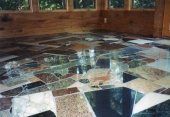




 1
1
















Seed the Mind, Harvest Ideas.
http://farmwhisperer.com




Best luck: satisfaction
Greatest curse, greed












I wasn't sure if you were asking me, or just in general. I guess there is several facets to answer you from.As an old tile installer, I'd strongly suggest staying with a thinset, for several reasons - not the least of which is a much better bond with much less material. As for grout, what's wrong with a standard large-particle portland cement grout?








Best luck: satisfaction
Greatest curse, greed




Jay C. White Cloud wrote:History of use in mosaic work would be the next reason. 12 years is a lot of experience; I would not devalue it or your knowledge. I would ask you to consider another perspective. Unless your 12 years of tile installation work included historical tile/mosaic antiquities, the study of traditional modalities and/or the restoration of traditional mosaics (some are thousands of years old.) Than I would reevaluate your approach, especially for a green house.
I must also share, that as a historical restoration specialist with 38 years of experience, I can not tell you how many times I have found tile, (large and small,) and mosaic work set in portland base bedding and grouting that begins to delaminate and crack. At it's very best, it seems to have a 40, maybe 50 year life span, before it has to be completely redone and/or replaced. Portland just does not work as well as some of the more traditional methods.
There are some expensive modern methods that are promising that involve epoxies, but again this expensive is outside the realm of most domestic applications.
I wish I had pictures of my mothers work, but this digital age is just beginning to catch up to "this old goat."




Thekla McDaniels wrote:
But as is apparent, I often disassemble and rebuild, it takes a few tries to understand what I needed to know at the beginning. Portland is not at all kind in that process, definitely a single use material (except urbanite). And it burns my skin.
The stone goes over the top of that, and so, I could not use thin set to put it on top of the sand. I have enough stone that I could put a layer down and then thinset a top layer onto it, but what a mess to take out if I need to.
And Jay, if you have any ideas of something better than the sand clay mix, at about 4 to one I'd love to hear them. As I write this I remember I had good luck adding wood glue to portland cement when I had to patch a 75 year old concrete cistern that was spalling badly. The places I patched 10 years ago are in place, without spalling or any other kind of frost damage.
Does it seem likely wood glue would be a good additive to the sand clay mortar? In on my heated green house bench? Casein glue, same as milk protein?




Best luck: satisfaction
Greatest curse, greed




I would agree that some of the rammed earth with lime, and rammed earth with natural cements, have lasted. I would also agree that most of the ancient formulas that came from nature that the Romans and Mesopotamians used have proven durable and are still studied for their secrets. But every modern concrete since 1824 and Joseph Aspdin's Portland has by now means proven durable. (http://www.auburn.edu/academic/architecture/bsc/classes/bsc314/timeline/timeline.htm) These modern formula, based on Aspdin's work, routinely break down and falter do to many incorporated, as well as, environmental factors. Every study that I have read, that calms other wise, has it's funding and or connection to the concrete industry in some manner. Ask any Bridge Engineer what the condition of modern Portland based concretes are in the infrastructure of this country. Read some of Frank Loyd Wright's own reservation about the poor quality of modern concrete. I could keep going, but my point has been made. Nothing is going to surpass the traditional methods of building with masonry, not at this time anyway. By the way, some of the oldest building in the world are wood, 2000 year old, and as far as ancient stone architecture it is either dry laid, or jointed with lime mortars, not portland.if done right, concrete will last for generations... can't find my copy of Snell and Callhan, but they did a good job of "defending" concrete, basically on the thought that it doesn't require upkeep, replacement, or suffer degradation as does straw, wood, etc.
You can not compare the two in any way. They are not apples and oranges. I do agree with your statement about workmanship and craft.Now, you hearken back to Portland cement, which really was a revolution, but mortars and concretes have been around for a helluva lot longer - as in Roman times.




Best luck: satisfaction
Greatest curse, greed








Pat Browne wrote:
I am looking for a material for the grout function...a terrazzo effect would be very nice.
Destruction precedes creation

| I agree. Here's the link: http://stoves2.com |




